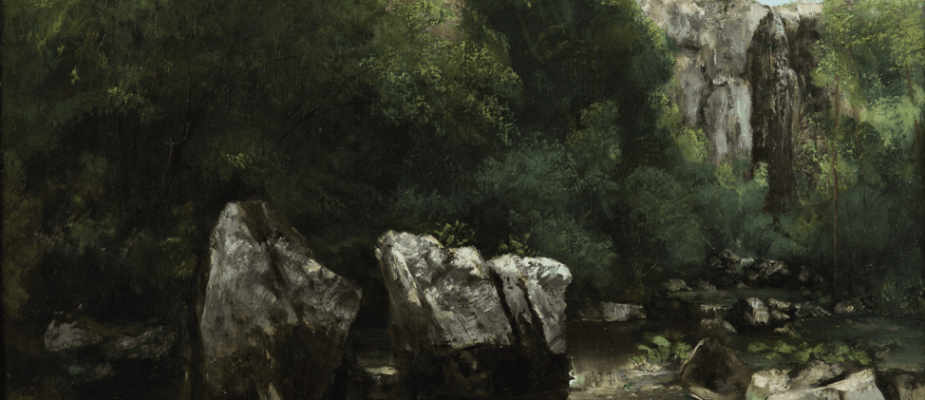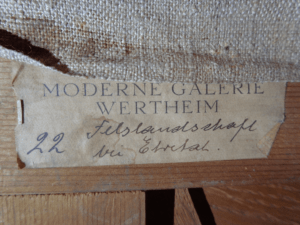Knowing the provenance, or ownership history, of a work of art can teach us a great deal. We often think of artworks as belonging to a museum or traveling with an exhibition, but most art objects also have a more secret past life. Who owned that painting before it was acquired by a museum? Was it displayed prominently in someone’s home? Or was it tucked away for no one else to see? Learning who owned a work of art provides a historical and cultural context that informs how we think about that art object today.
For the past year, Bryn Schockmel, Kress Fellow for Provenance Research at the Oklahoma City Museum of Art, has been researching the provenance of a variety of art objects in the Museum’s permanent collection. The following post explores what she uncovered about the above painting, Gorge in the Forest (The Black Well), by French artist Gustave Courbet, painted around the year 1865.
Gustave Courbet was born in the small city of Ornans, in eastern France, in 1819. As part of the Realism art movement, he took his inspiration from scenes of everyday life, as opposed to historical or mythological motifs. Courbet was working at a time of transition in the art world in France, as new, modern styles were coming to the fore; he was very influential on the next generation of artists, including many of the Impressionists, such as Claude Monet. The French title for the Museum’s painting is Le Puits Noir, and refers to a secluded locale not far from the city of Ornans, near the border with Switzerland. Courbet painted this spot numerous times, beginning in 1855. Other versions of this subject can now be found at the National Gallery of Art in Washington, DC, at the Norton Simon Museum in Pasadena, and at the Musée d’Orsay in Paris.
When researching the provenance of an object, we try our best to compile a complete ownership history, from the time of an object’s creation until the time it was acquired by the Museum. It is particularly important to trace the provenance of an object that was in Europe between 1933 and 1945. This is because during World War II, the Nazis, under the orders of Adolf Hitler, systematically looted art from museums, galleries, and private collections across Europe. When I began researching our Courbet, I learned that the painting had been in Paris in 1920 and in Munich by 1967, so I prioritized uncovering its history during the Nazi-era.
There are many avenues of approach for conducting provenance research. A catalogue raisonné—a book that lists all the known works of an artist in a particular medium—is a helpful starting point. From the Courbet catalogue raisonné, published in 1977, I learned of two sales of our painting in Paris, in 1908 and 1920; tracking down those catalogs provided helpful information on the painting’s early history. From a document in our object file on the painting, I learned that our Courbet was sold at Christie’s London auction house on December 1, 1967. The catalog from that sale informed me that the painting was owned by K. Kienlechner of Munich, who had inherited the work from her grandmother, Lisa Boner, also of Munich. This still left me with a gap from 1920 to 1967, covering the critical years during World War II. Fortunately, a clue on the back of the painting provided some answers.
Artworks themselves can be very useful tools when conducting provenance research. They may have labels or stamps on the back indicating past exhibitions, owners, or auctions. A label on the back of our Courbet that says “Moderne Galerie Wertheim” with the title “Felslandschaft bei Etretat” and the number “22” written below proved to be an important clue. It led to an exhibition catalog that I found through an online catalog of thousands of libraries worldwide, an incredibly useful resource for provenance research. Using the database, I can search key words, such as “Courbet” and “Wertheim.” This led me to the catalog for an exhibition of paintings by Courbet at the Galerie Wertheim in Berlin in 1930.
In the catalog I found a work with a title matching that written on the label, and Dr. Franz A. Boner was listed as a lender to the exhibition. With further research I learned that the Museum’s Courbet was part of Dr. Boner’s collection, and, when he died in 1941, it was inherited by his wife, Lisa Boner. She died in 1967 and the work was sold at Christie’s by her granddaughter that same year. Therefore, the painting remained in the possession of one family for the duration of World War II.
Archival research enabled me to learn more about the painting’s recent history. At major auction houses, after all the sales have been completed, a price list is often added to the back of the catalog listing who purchased the various works and for what price. A copy of the 1967 Christie’s auction catalog at the Kimbell Art Museum Library included such a price list, naming the purchaser as “Heim Gallery.” While at the Getty Research Institute, I had the opportunity to examine files from Heim Gallery of London. Their stock book confirmed that they did indeed purchase the Courbet at Christie’s in 1967, and then immediately sold the work to a man named Edward Carter. An invoice addressed to Edward W. Carter of Los Angeles revealed that Heim Gallery had purchased the painting on his behalf, for a fee of £100.
Provenance research is complex and ongoing. As new records and documentation come to light, the provenance of works of art are updated or corrected as needed. At the Oklahoma City Museum of Art, we write provenance in paragraph format, starting with the earliest known owner and ending with the Museum. Semi-colons indicate that a work transferred directly from one owner to the next, whereas a period indicates a possible gap in the ownership history. Though I have yet to uncover the provenance of our Courbet before the twentieth century, and still have some gaps in its history, we have confirmed that the painting does not have a problematic history during World War II, and through provenance research have learned much that adds to our understanding and appreciation of this great work of art.
Provenance:
P. A. Chéramy, Paris, 1908; (Collection P. A. Chéramy Sale, Galerie Georges Petit, Paris, May 5-7, 1908, no. 142) [1]. (Galerie Georges Petit Sale, Paris, March 4-5, 1920, no. 29) [2]. Dr. Franz Anton Boner [1868-1941], Berlin, by 1930 (?) [3]; Lisa Boner [1881-1967], Munich, 1941 [4]; inherited by K. Kienlechner, Munich [5]; (Christie’s Sale, London, December 1, 1967, no. 14) [6]; purchased by Heim Gallery, London [7]; purchased by Edward W. Carter [1911-1996], Los Angeles, December 12, 1967 [8]. Jean Paul Ledeur [b. 1933], Paris (?) [9]. Acquavella Galleries, New York City, by November 1977 [10]; purchased by Sylvan Goldman [1898-1984], Oklahoma City, 1977; extended loan to Oklahoma Museum of Art, 1977; given to Oklahoma Museum of Art, December 28, 1981; transferred to Oklahoma City Art Museum, 1989; transferred to Oklahoma City Museum of Art, 2002.
[1] Galerie Georges Petit, Catalogue (1908), no. 142; Christie’s, Catalogue (1967), no. 14; and Fernier, Gustave Courbet (1978), no. 378
[2] Galerie Georges Petit, Catalogue (1920), no. 29 and Fernier, Gustave Courbet (1978), no. 378
[3] Galerie Wertheim, Ausstellung Gustav Courbet (1930), no. 47 (?); Kienlechner, “Una Versione sconosciuta della Tela di Giovanni Battista Tiepolo,” (2019), pg. 65; and label on verso that reads “Moderne Galerie Wertheim / Felslandschaft bei Etretat / 22”
[4] Christie’s, Catalogue (1967), no. 14 and Fernier, Gustave Courbet (1978), no. 378; Lisa Boner was the wife of Franz Boner
[5] Christie’s, Catalogue (1967), no. 14, in which it is noted that Lisa Boner was the grandmother of K. Kienlechner, and Fernier, Gustave Courbet (1978), no. 378; at times spelled Kienlechnew, see Reeve, Masters of the Landscape (1977), no. 24
[6] Christie’s, Catalogue (1967), no. 14
[7] Heim Gallery, Stock Book (1966-1970), pg. 27 (Getty Research Institute, Box 202) and Christie’s, Catalogue (1967), no. 14, see list of prices and buyers
[8] Heim Gallery, invoice dated December 1, 1967 and marked as paid December 12, 1967 (Getty Research Institute, Box 207); Heim Gallery purchased the work at auction on behalf of Edward W. Carter
[9] Courthion, Courbet (1985), no. 418 lists the work as being in the collection of J. P. Ledeur, however at the time of publication (1985) the work had already been at the Oklahoma Museum of Art for eight years; Fernier, Gustave Courbet (1977), no. 378 also lists Ledeur as a previous owner, but other flaws have been found with the provenance provided in that book
[10] Reeve, Masters of the Landscape (1977), no. 24
The Museum relies on admission revenue from our galleries and films as well as donations to provide rich cultural and educational experiences for all. Please consider making a gift of any size to support the Museum as our community continues to shelter in place.
Credit: Gustave Courbet (French, 1819–1877) Gorge in a Forest (The Black Well), ca. 1865. Oil on canvas. Gift of Mr. and Mrs. Sylvan Goldman, 1981.173











